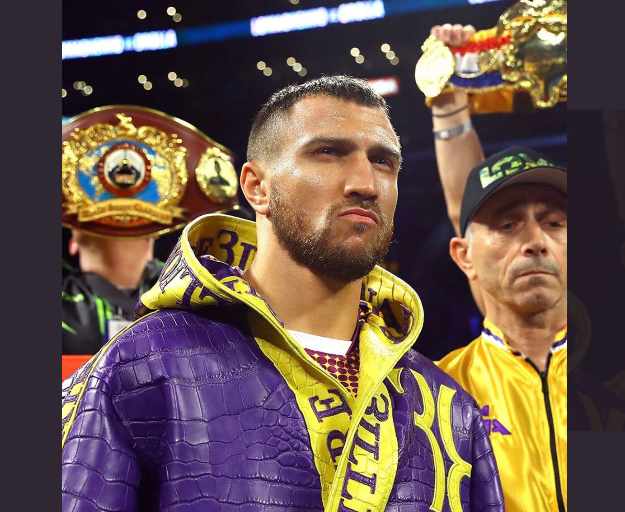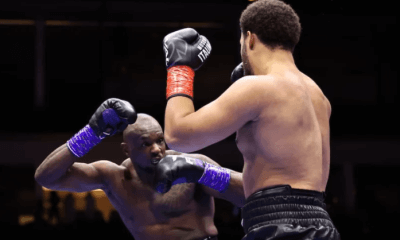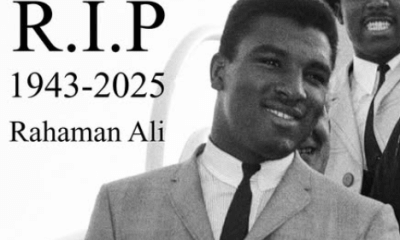Featured Articles
Does Lomachenko Still Have Enough Blue-Book Value to Motor Past Lopez?

In December 2017, a few days prior to Vasiliy Lomachenko’s dominant performance against Guillermo Rigondeaux, who quit on his stool after six rounds at the Theater at Madison Square Garden, noted trainer and ESPN boxing analyst Teddy Atlas was unabashedly exuberant in his assessment of the Ukrainian southpaw’s myriad qualities. To Teddy’s way of thinking, Lomachenko, who went into the Rigondeaux fight with a 9-1 pro record, already had stamped himself as a potential all-time great.
“He’s David Copperfield,” Atlas, referencing the famous magician, gushed of the then-29-year-old Lomachenko. “He makes you think something’s happening over here because that’s what he wants you to think. Look, I had Lomachenko rated in my top 10 pound-for-pound after one pro fight. Yeah, I did, and I know why I did. And I know why I have him No. 1 now. He was born to fight and has been trained to do just that almost from the time he came out of his mother’s womb.
“Mentally, physically, emotionally, technically … he’s the best at all of it, or close to it. It’s no accident he is where he is. He’s the whole package. There are guys you can argue that have better separate pure athletic skill sets, but Lomachenko puts the whole package better than anybody.”
As Loma (14-1, 10 KOs) counts the days down to what arguably is the most compelling, most-anticipated matchup of 2020, Saturday night’s ESPN-televised lightweight unification showdown with 21-year-old firebrand Teofimo Lopez (15-0, 12 KOs) in Las Vegas’ MGM Grand “Bubble,” Atlas’ lofty praise of a seemingly flawless fighter remains unchanged. Well, maybe a little. To Teddy’s way of thinking, predicting the outcome of a fight, any fight, is like shopping for a quality used car. Blue book value matters. A vehicle being considered for purchase might be exquisite on the outside, but before a prospective buyer takes the plunge it always is advisable to check under the hood.
Three 135-pound titles – the WBA and WBO ones held by Lomachenko and the IBF version held by Lopez – will be on the line, as well as the unofficial “franchise” designation conferred upon Loma by the WBC, separate and apart from that sanctioning body’s recognition of Devin Haney as its standard-issue lightweight champion.
There are reasons why Lomachenko, now 32, is a fairly substantial favorite, at -400 according to the Vegas sports books compared to +300 for Lopez. In a poll of so-called experts by one boxing website, Lomachenko was seen as the winner by 18 of 20 respondents. But Atlas sees the matchup as potentially problematic for a still-great practitioner of the pugilistic arts whose heavy wear and tear over a lifetime of highway usage might soon, if not immediately, require a tuneup.
“It’s a dangerous fight for Lomachenko,” Atlas said. “He might have been better off if the fight had happened two years earlier. I don’t judge a fighter’s age chronologically. I judge it the way I judge a car’s age, which is by the mileage on the odometer. A car might be 10 years old, but if it’s got only 5,000 miles on the odometer, to me it’s still a pretty new car. And if you have a car that’s five years old and it has 100,000 miles on the odometer, it’s an old car.
“Lomachenko had, like, 400 amateur fights. (He was an astounding 396-1, with two Olympic gold medals.) He’s only 32, but you don’t know when the effect of all that mileage is going to start to show. I still think he’s the best fighter in the world pound-for-pound. He and (Terence) Crawford are No. 1 and No. 2, or maybe the other way around. Either way you can’t go wrong. Lomachenko is the best technical fighter on the planet. But, at 32, he might be getting to a place where he’s starting to step a tiny bit into the shadows – maybe not enough where everyone’s going to notice it, but I notice a tiny bit of that.
“If that’s true, it makes this fight even more dangerous for him, going up against a young guy who’s so explosive, and not just as a puncher. What I see from this kid is a real belief in himself. He’s nine years younger, he’s naturally bigger, he not only has power but quick feet. He closes the gap the way Manny Pacquiao used to do years ago. Yeah, Pacquiao could punch hard, but the thing that made him especially dangerous was that he could explode in that last couple of feet before the other guy could react. Lopez has that quickness and suddenness.”
It has been suggested by some that Lomachenko-Lopez mirrors the Sept. 14, 2013, pairing of Floyd Mayweather Jr. and Canelo Alvarez, which ended in a 12-round majority decision for Mayweather, although most observers believed “Money” deserved a clear and unanimous nod, and would have gotten it were it not for the widely criticized 114-114 scorecard submitted by judge C.J. Ross. There are those who contend that Canelo, then 23, lost mostly because of his relative youth and inexperience. Atlas believes any attempt to draw parallels between the two megafights is flawed, mostly because of differences between the Canelo that was then and the Lopez that is now.
“The Mayweather-Canelo model is not a fair comparison,” Atlas said, noting that Alvarez, who turned pro at 15, went into that fight with a 42-0-1 record and 30 KOs, making him much more of a finished product than the Lopez who will swap punches with Loma. “And besides, I just don’t think Canelo was ever going to have the foot speed to close the gap against Mayweather before he got countered, and that’s something Lopez does have. Canelo had the hand speed, but he was too slow for Mayweather with his feet. I just think it was never going to be the right time for him to win against Mayweather, because of their styles.”
Lopez’s closing burst from Point A to Point B, along with the power to put away most opponents with a single, well-placed shot, make him the sternest test Lomachenko has ever faced inside the ropes. Then again, the opposite also applies. Can Lopez solve the puzzle that Lomachenko, so adept at flummoxing frustrated foes with nimble moves, quick pivots and an ability to deliver stinging punches from unorthodox angles, always poses?
“He moves like he’s playing three-dimensional chess,” Top Rank founder Bob Arum, who promotes both fighters, once said of Lomachenko. “Watching him fight is like watching a fighter paint a great masterpiece.”
But even great masterpieces can be smudged, and in some of his more recent outings Lomachenko has dropped the occasional hint that even an exquisite artist such as himself can be something less than perfect.
“I think Lomachenko is getting hit a little bit more than he used to,” Atlas said. “He got caught a couple of times by (Luke) Campbell, who is not a big puncher. He got dropped by (Jorge) Linares. If that happens with Lopez, it definitely could be a problem.”
For his part, Lopez – whose nickname is “The Takeover,” which is what he expects to do to the sport of boxing once the world at large sees what he is capable of against Lomachenko – is convinced he will demonstrate that even the man of many moves can be put down and out if caught just so.
“He’s on the way out,” Lopez said in an interview with DAZN. “He really thinks he is a god in this sport. I don’t like him and I have my reasons why. I don’t like the way he carries himself. I will beat up Lomachenko and take his belts. Simply as that.
“I’m not the type of fighter to just talk my stuff and not back it up. If I hit him like Linares did, he won’t get up. If he gets knocked down by me, it’s over.”
Simple is as simple does, and Lomachenko has heard past victims talk trash and then have their mouths taped shut inside the ropes. He praised Lopez as an “excellent puncher” with a “high boxing IQ,” but he has heard all the implied threats before and considers them meaningless unless or until the boastful opponent backs up the bluster with victorious action.
“I heard this a lot of times from a lot of boxers,” Lomachenko said of the latest verbal assault directed at him. “But then you come in the ring, and you forget your words. You forget your promise. You just try boxing, you just try fighting. For me, it’s just words.
“Teofimo Lopez can talk all he wants. He’s very good at talking. He has done nothing but say my name for the past two years. Good for Teofimo. When we fight he will eat my punches and his words.”
Now, about the words uttered two years ago that caused Lopez and his trainer-father, Teofimo Sr., to make the conquest of Lomachenko something akin to a holy quest. Appearing on the same Dec. 8, 2018, card at the Theater at Madison Square Garden, Loma outpointed Jose Pedraza en route to a 12-round, unanimous decision to retain his WBA lightweight title while annexing Pedraza’s WBO belt. The Brooklyn-born Lopez, meanwhile, might have stolen the show by starching veteran Mason Menard only 44 seconds into round one. Two nights earlier, the elder Lopez, apparently inebriated, confronted Lomachenko in the hotel where both fighters were staying and told him that at some point his son would “kick your ass.”
Egos, not surprisingly, were involved, and feelings bruised, with a fight that probably was predestined to happen anyway someday now coated with genuine undertones of animosity. For his part, Teofimo Lopez sided with his father in the belief that Lomachenko and his trainer-father, Anatoly Lomachenko, were guilty of being arrogant and dismissive.
Lomachenko is almost always imperturbable, a craftsman not disposed to outwardly showing emotion, but Lopez might be more prone to venting any anger he could be harboring on fight night. And that, Atlas said, likely would be to Loma’s advantage.
“I don’t think it can be a plus for Lopez,” Atlas said of fighters who are more concerned with inflicting as much punishment as possible on their opponent for personal reasons than with executing a fight plan. “It makes you more reckless and more prone to think less and be careless. I think that factor in overplayed in most cases and I disregard it in this instance, but who knows?”
Check out more boxing news on video at the Boxing Channel
To comment on this story in the Fight Forum CLICK HERE
-

 Featured Articles4 weeks ago
Featured Articles4 weeks agoThe Hauser Report: Zayas-Garcia, Pacquiao, Usyk, and the NYSAC
-

 Featured Articles3 weeks ago
Featured Articles3 weeks agoOscar Duarte and Regis Prograis Prevail on an Action-Packed Fight Card in Chicago
-

 Featured Articles2 weeks ago
Featured Articles2 weeks agoThe Hauser Report: Cinematic and Literary Notes
-

 Book Review2 weeks ago
Book Review2 weeks agoMark Kriegel’s New Book About Mike Tyson is a Must-Read
-

 Featured Articles4 weeks ago
Featured Articles4 weeks agoRemembering Dwight Muhammad Qawi (1953-2025) and his Triumphant Return to Prison
-

 Featured Articles7 days ago
Featured Articles7 days agoMoses Itauma Continues his Rapid Rise; Steamrolls Dillian Whyte in Riyadh
-

 Featured Articles3 weeks ago
Featured Articles3 weeks agoRahaman Ali (1943-2025)
-

 Featured Articles3 weeks ago
Featured Articles3 weeks agoTop Rank Boxing is in Limbo, but that Hasn’t Benched Robert Garcia’s Up-and-Comers



















